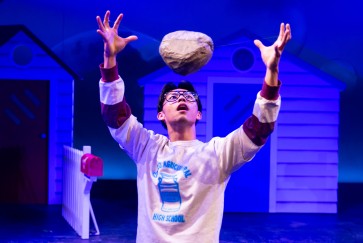The story of Orpheus and Eurydice has fueled the imaginations of artists for centuries. There are numerous books, plays and films all adapted from this timeless myth. Now, the Greek tale is being told on the stage of the world-famous Metropolitan Opera in New York under the direction and design of award-winning School of Communication faculty members Mary Zimmerman and Ana Kuzmanic.
A co-commission and co-production with the Metropolitan Opera, “Eurydice” premiered at the Los Angeles Opera last year just before the COVID-19 pandemic. The new opera was originally scheduled to receive its Met premiere in November 2020, but was postponed due to the pandemic. The adaption features a libretto based on Sarah Ruhl’s 2003 play and music by Matthew Aucoin.
The opera boasts a set designed by Northwestern alumnus and former faculty member Daniel Ostling ’96. “Eurydice” is the sixth collaboration between Zimmerman, as director, and Kuzmanic ’04, as costume designer.
Bringing the heroine out of the shadows
“Eurydice” reimagines the ancient myth of Orpheus and Eurydice for a modern age. The story brings the heroine out of the shadows and into the forefront of her own narrative. Just a few hours after her wedding, Eurydice dies and descends into the Underworld. Reunited there with her late father, Eurydice attempts to piece together memories of her life on Earth. But when Orpheus miraculously arrives to take Eurydice back to the living, she must decide between her adoring father or her devoted husband.
“When working with Mary [Zimmerman], I know her aesthetic will blend the mythical with contemporary references,” Kuzmanic said when asked about what informed her approach to the costume design.
“In our early discussions we talked about love, people falling in love and marrying. We wanted the silhouette of Eurydice’s wedding dress to be traditional — almost archetypal,” Kuzmanic said. “We also talked about grief as a human experience that every individual experiences in a unique way. As time passes, we wanted to show the visible impact of the Underworld on Eurydice. Her dress keeps changing by absorbing the darkness of the Underworld in a way unique to Eurydice and her grief.”
While “Eurydice” is Kuzmanic’s first design project at the Met, she has worked with other famous opera houses, including the Lyric Opera of Chicago and The Dallas Opera. She made her Broadway debut with the Pulitzer and Tony award-winning play “August: Osage County.”
“When you find someone, your tastes have to align,” Zimmerman said, reflecting on her professional work relationship and friendship with Kuzmanic.
“I think your level of commitment, passion and love of what you do also has to align,” Zimmerman said. “A willingness to half kill yourself is part of everyone I work with. I think when you find those people who approach the profession in the same way, you really form a connection.”
I think when you find those people who approach the profession in the same way, you really form a connection.”
Zimmerman, the Jaharis Family Foundation Chair in Performance Studies, is no stranger to mythology. She won a Tony Award for her aquatic adaptation of Roman poet Ovid’s “Metamorphoses,” which had its original workshop production at Northwestern.
This is Zimmerman’s fifth time directing at the Metropolitan Opera. The 1998 MacArthur Foundation Genius grant recipient calls her time at the Met a “crazy learning curve.” She says she now feels “comfortable” directing at the historic venue but admits productions there can be more challenging than adapting and directing a play for a traditional theater company like Chicago’s Steppenwolf or Lookingglass theaters.
Directing and designing for opera
Zimmerman is known for developing her original shows in an unusual way — starting rehearsals with no script and writing each day’s material the night before. She found opera to be completely different.
“With opera, I’m not in control,” Zimmerman says. “I mean, a lot of what you do as a director of a play is determine the pace of the scene. In the opera world, the score has made those decisions for you. I am not in charge of the actors’ voices at all. I’m a little bit reduced to how they move, where they move, when they move and trying to get them to be able to move comfortably while doing a highly artificial thing.”
Kuzmanic says there is an “incredible freedom” to operatic costume design. However, like directing, designing costumes for operas comes with its own unique challenges. The stories are performed on a grand level. Opera houses are massive spaces. Those two elements have a big impact on design choices.
“The scale (of costumes) is completely different (from a theater production),” Kuzmanic said. “Because when you look at any opera house, the first row of the audience is far away from the stage. You have to imagine how the costume is going to look from at least 20 or more feet away and then, of course, you have the entire auditorium behind it.”
The result — patterns and colors of the clothing must be bolder and designs more exaggerated.
Getting to opening night at the Met has its own challenges for both Zimmerman and Kuzmanic. Pre-production time (when costumes, sets, and lighting are designed) is truncated, compared to a typical theater schedule. Even the time to rehearse on stage is limited because several operas share the same stage. In the theater world, rehearsals could go on for 12 hours. At the Met, that time could be limited to just four hours.
“At the Met, every minute you hear the second hand just ticking because you have so little time,” Zimmerman said. “I feel like opera is kind of crazy because so much time, effort and money are put into it, but they don’t typically give it the technical rehearsal time. It’s crazy, but it’s also thrilling.”

